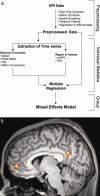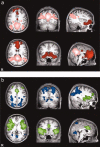Functional connectivity of default mode network components: correlation, anticorrelation, and causality
- PMID: 18219617
- PMCID: PMC3654104
- DOI: 10.1002/hbm.20531
Functional connectivity of default mode network components: correlation, anticorrelation, and causality
Abstract
The default mode network (DMN), based in ventromedial prefrontal cortex (vmPFC) and posterior cingulate cortex (PCC), exhibits higher metabolic activity at rest than during performance of externally oriented cognitive tasks. Recent studies have suggested that competitive relationships between the DMN and various task-positive networks involved in task performance are intrinsically represented in the brain in the form of strong negative correlations (anticorrelations) between spontaneous fluctuations in these networks. Most neuroimaging studies characterize the DMN as a homogenous network, thus few have examined the differential contributions of DMN components to such competitive relationships. Here, we examined functional differentiation within the DMN, with an emphasis on understanding competitive relationships between this and other networks. We used a seed correlation approach on resting-state data to assess differences in functional connectivity between these two regions and their anticorrelated networks. While the positively correlated networks for the vmPFC and PCC seeds largely overlapped, the anticorrelated networks for each showed striking differences. Activity in vmPFC negatively predicted activity in parietal visual spatial and temporal attention networks, whereas activity in PCC negatively predicted activity in prefrontal-based motor control circuits. Granger causality analyses suggest that vmPFC and PCC exert greater influence on their anticorrelated networks than the other way around, suggesting that these two default mode nodes may directly modulate activity in task-positive networks. Thus, the two major nodes comprising the DMN are differentiated with respect to the specific brain systems with which they interact, suggesting greater heterogeneity within this network than is commonly appreciated.
Figures





References
-
- Amodio DM,Frith CD( 2006): Meeting of minds: the medial frontal cortex and social cognition. Nat Rev Neurosci 7: 268–277. - PubMed
-
- Bellec P,Perlbarg V,Jbabdi S,Pelegrini‐Issac M,Anton JL,Doyon J,Benali H( 2006): Identification of large‐scale networks in the brain using fMRI. Neuroimage 29: 1231–1243. - PubMed
-
- Birn RM,Diamond JB,Smith MA,Bandettini PA( 2006): Separating respiratory‐variation‐related fluctuations from neuronal‐activity‐related fluctuations in fMRI. Neuroimage 31: 1536–1548. - PubMed
-
- Biswal B,Yetkin FZ,Haughton VM,Hyde JS( 1995): Functional connectivity in the motor cortex of resting human brain using echo‐planar MRI. Magn Reson Med 34: 537–541. - PubMed
-
- Buckner RL,Carroll DC( 2007): Self‐projection and the brain. Trends Cogn Sci 11: 49–57. - PubMed
Publication types
MeSH terms
Grants and funding
LinkOut - more resources
Full Text Sources
Other Literature Sources

